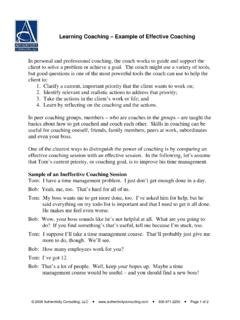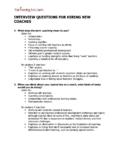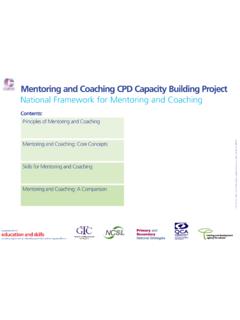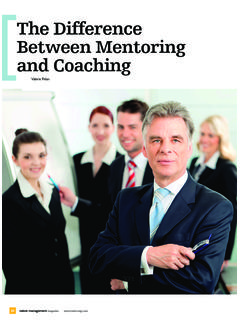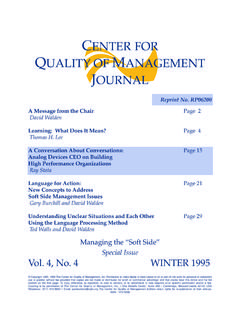Transcription of Seven coaching conversations - David Clutterbuck
1 Seven coaching conversations Being an effective coach requires a continuously expanding portfolio of MDQs -- Massively Difficult Questions. These are what stimulate the client to reflect and gain personal insight. Equally important, however. are the MDQs we ask ourselves. For example: For whose benefit am I asking this question? Can I do more here by saying nothing? What am I afraid of in this conversation or situation? What can I learn from this person? What emotions am I feeling and to what extent are these influencing my approach the client's issue? The coaching conversation is actually Seven conversations : 1. My dialogue with myself before the session 2. The client's inner dialogue before the session 3. My inner dialogue during the conversation 4. The spoken dialogue 5. The client's inner dialogue during the conversation 6. My reflection after the conversation 7.
2 The client's reflection after the conversation Most coach training focuses on the middle of these -- the spoken dialogue. Yet the effectiveness of the spoken dialogue depends heavily on the other six conversations . Building our competence in each of the conversations is essential in mastering the coaching role. The coach s initial inner dialogue The purpose of this dialogue is to ensure that the coach is mentally prepared for the coaching conversation. The quality of the conversation is dependent, to a significant extent, on the quality of thinking both coach and coachee put into their preparation although spontaneity of dialogue still plays a major role, too! Useful questions include: How have I helped so far? What are my motivations in this relationship? What is the big picture for this client? Do I really understand what drives them? What is this client avoiding?
3 What am I avoiding? How do I feel about this relationship? Am I looking forward to this meeting? (If not, what s the issue and what should I be doing about it?) What are my responsibilities in this relationship? Who else is present and in what ways? The client s initial inner dialogue Preparation by the coachee is equally important and can be equally demanding. At least an hour s quality reflective space is typically required to prepare for an intensive coaching session. Questions mentees can ask of themselves before the meeting include: What has happened to me since our last meeting? How have I changed? What issues have been resolved and what new issues have arisen? What s the relationship between these issues and my overall goals? What thinking have I already done around these issues? How do I want my coach to help? What information can I provide to help the coach understand the issue?
4 Do I really want to resolve this issue? What are my motivations for introducing it now? How do I feel about this relationship? Am I looking forward to this meeting? (If not, what s the issue and what should I be doing about it?) What are my responsibilities in this relationship? The coach s inner dialogue during the spoken conversation This inner dialogue takes place in parallel with the process of listening and asking questions. Sometimes called reflection-in-action , it requires us to both participate fully in the conversation and observe it as dispassionately as possible. In some ways, it s like the running commentary advanced drivers use, when they talk themselves through how they observe the road ahead of them. Useful questions include: What is the quality of my listening? (Am I fully focused on the client?) What am I observing/ hearing? What am I missing?
5 Is my intuition turned on? What assumptions am I making? How might these be acting as a filter on my listening and my understanding? Am I spending too much attention on crafting the next question? (Is this affecting my ability to be in the moment ?) How am I helping? What is the client not saying? What is the quality of the client s thinking? How am I feeling in the moment? If I feel uncomfortable, what is making me so? How is the client feeling at this moment? The spoken conversation This is the part that attracts the most attention. It s also the easiest conversation and therefore highly beguiling. Inexperienced or inexpert coachs frequently are aware only of this conversation, and oblivious to the inner conversations going on simultaneously in themselves and the client (if they have an inner conversation at all!). Effective coachs maintain awareness of all three, while instinctively reviewing the dynamics of the spoken conversation, asking themselves questions such as: Is there consonance between what is said and our body language?
6 Is there a logical pattern of development to the conversation? Are we exploring issues from multiple perspectives? Who is doing most of the talking/ coming up with most of the ideas?/ asking most of the questions? Is the pace sufficiently varied (eg is there space for both quiet reflection and rapid building on ideas?) Are we both engaged in the conversation? Are we exploring issues in sufficient depth? The mentee s inner dialogue during the spoken conversation The coachee can contribute more to the learning dialogue, if he or she is also process-aware. The management of the conversation and its direction become a shared activity. It s a further step, however, to becoming aware of the inner conversation. The coach can help build that awareness by interrupting the flow of the spoken conversation at appropriate times to raise the mentee s internal awareness, helping them to reflect upon questions, such as: How open and honest am I being with myself and with my coach?
7 Am I saying what I want to say? What assumptions or filters am I applying in answering the coach s questions? How am I feeling about the conversation? If I feel uncomfortable, what is making me so? How is my coach feeling at this moment? What are the opportunities for learning in this conversation? How am I helping the coach understand my issues? In due course, some mentees learn how to carry on the inner conversation without prompting from the coach. The coach s inner conversation after the meeting Reflection-on-action is also a critical part of the coach s continuous improvement and personal growth. While the meeting is still fresh in his or her memory, the coach should review the five antecedent conversations , asking, for example: How did I help? What insights did we create together? What did I do to enhance the quality of the mentee s thinking?
8 Was I appropriately directive/ non-directive? Where did I struggle? Did we create a bias for action ? What insightful questions did I ask, which might be useful in other learning conversations ? What questions did I withhold and why? Was I sufficiently challenging? Did I receive sufficient challenge in return? Did I give the coachee sufficient time to think? What did I learn? What patterns can I discern from this and previous conversations with this client? What would I do differently another time? Am I still looking forward to the next meeting? What can I usefully discuss with my supervisor? The mentee s inner conversation after the meeting The mentee s post-meeting reflection is vital in terms of translating good thoughts into practical action. The thinking process can be helped through questions such as: What did I learn?
9 How am I going to put that learning into practice? What do I need to think about more deeply? What do I want to explore with other people? Was I sufficiently open and honest? What could I have done to extract more value from the conversation? What could I have done to make it more enjoyable for my coach? What changed expectations do I now have of myself? How do these align with other people s expectations of me? Am I still looking forward to the next meeting? Each of these conversations requires an appropriate space and sufficient time (at least half an hour in most cases) for reflection. The quality of reflection at each stage can also be improved through: Initial mental relaxation exercises to establish an appropriate mental state Doing something completely different and enjoyable beforehand, to stimulate creativity Considering what psychological contract we have with ourselves about coaching in general and this relationship in particular Being as open as one can to discovery about the context, other people and oneself For the coach, it can also be valuable to summarise reflection by thinking what your supervisor might say, were they listening in.
10 What elements of each of the Seven conversations would be helpful in giving the supervisor greater insight into the dynamics of the issues and how you approached them? Other useful questions include: What am I aware of, but have not yet recognised or acknowledged? What is the coachee aware of, but has not yet recognised or acknowledged? What is the quality of the learning that is taking place? How have I contributed to that? How can my reflection-on-practice and reflection-in-action improve my performance as a coach? The Seven conversations provide a useful framework for planning a coaching intervention. They can also be valuable in helping the client understand how they can make the most of the learning dialogues, in which they engage. David Clutterbuck , 2006



